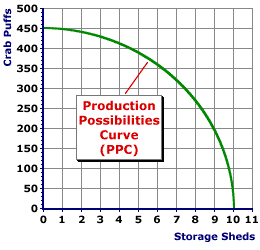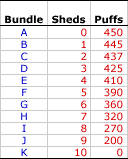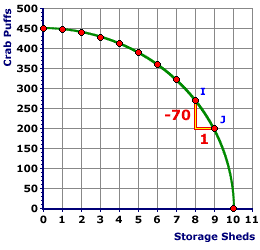
|
|
SCIENTIFIC METHOD: A structured way of investigating and explaining the operation of the world by testing and verifying hypothesized relationships. The scientific method is a process of discovery, a method of explaining phenomena that can be better understood with an overview of theory, principles, world view, hypothesis, and verification.
Visit the GLOSS*arama
|
|


|

|
                           PRODUCTION POSSIBILITIES CURVE: A curve that illustrates the production possibilities of an economy--the alternative combinations of two goods that an economy can produce with given resources and technology. A production possibilities curve (PPC) represents the boundary or frontier of the economy's production capabilities, hence it is also frequently termed a production possibilities frontier (PPF). As a frontier, it is the maximum production possible given existing (fixed) resources and technology. Producing on the curve means resources are fully employed, while producing inside the curve means resources are unemployed. The law of increasing opportunity cost is what gives the curve its distinctive convex shape. | Production Possibilities Curve |  |
Production possibilities is an analysis of the alternative combinations of two goods that an economy can produce with existing resources and technology in a given time period. This analysis is often represented by a convex curve.A standard production possibilities curve for a hypothetical economy is presented here. This particular production possibilities curve illustrates the alternative combinations of two goods--crab puffs and storage sheds--that can be produced by the economy. The Set UpAccording to the assumptions of production possibilities analysis, the economy is using all resources with given technology to efficiently produce two goods--crab puffs and storage sheds. Crab puffs are delicious cocktail appetizers which have the obvious use of being eaten by hungry people, usually at parties. Storage sheds are small buildings used to store garden implements, lawn mowers, and bicycles.This curve presents the alternative combinations of crab puffs and storage sheds that the economy can produce. Production is technically efficient, using all existing resources, given existing technology. The vertical axis measures the production of crab puffs and the horizontal axis measures the production of storage sheds. | Production Possibilities Schedule |  |
The production possibilities curve should be compared with the production possibilities schedule, such as the one presented to the left. A schedule presents a limited, discrete number of production alternatives in the form of a table. The production possibilities curve, in contrast, presents an infinite number of production alternatives that reside on the boundary of the frontier. The production possibilities schedule is commonly used as a starting point in the derivation of the production possibilities curve.Key Economic ConceptsAs a introductory model of the economy, the production possibilities curve is commonly used to illustrate basic economic concepts, including full employment, unemployment, opportunity cost, economic growth, and investment.- Opportunity Cost: This is indicated by the negative slope of the production possibilities curve (or frontier). As more storage sheds are produced, fewer crab puffs are produced. This reduction in the production of crab puffs is the opportunity cost of storage shed production.
- Full Employment: This is indicated by producing on the production possibilities curve. The curve indicates the maximum production of crab puffs and storage sheds obtained with existing technology, given that all available resources are engaged in production.
- Unemployment: This is indicated by producing inside the production possibilities curve. If some available resources are not engaged in production, then the economy is not achieving maximum production.
- Economic Growth: This is indicated by an outward shift of the production possibilities curve, which is achieved by relaxing the assumptions of fixed resources and technology or by increasing the quantity or quality of resources. With economic growth more of both goods, crab puffs and storage sheds, can be produced.
- Investment: This is indicated by a tradeoff between the production of consumption goods (crab puffs) and capital goods (storage sheds). Investment results if society moves along the production possibilities curve, producing more capital goods and fewer consumption goods.
SlopeSlope of the
Production Possibilities Curve |  |
The slope of a line is measured by calculating the change in the value measured on the vertical axis divided by the change in the value measured on the horizontal axis. Another way of saying this is to divide the rise by the run.For the production possibilities curve to the right, this is the change in the quantity of crab puffs (rise) divided by the change in the quantity of storage sheds (run). Here is a handy formula for calculating the slope of the production possibilities curve. | slope | = | rise
run | = | change in crab puffs
change in sheds |
For example, the slope of the production possibilities curve between points I (8 sheds and 270 dozen crab puffs) and J (9 sheds and 200 dozen crab puffs) is -70. The rise is a decrease of 70 and the run is an increase of 1. | slope, I to J | = | change in crab puffs
change in sheds | = | -70
1 | = | -70 |

Recommended Citation:PRODUCTION POSSIBILITIES CURVE, AmosWEB Encyclonomic WEB*pedia, http://www.AmosWEB.com, AmosWEB LLC, 2000-2025. [Accessed: July 18, 2025].
Check Out These Related Terms... | | | | | | | | |
Or For A Little Background... | | | | | | | | | | |
And For Further Study... | | | | | | | | | | | |
Search Again?
Back to the WEB*pedia
|



|

|
BLUE PLACIDOLA
[What's This?]
Today, you are likely to spend a great deal of time searching the newspaper want ads looking to buy either a wall poster commemorating the first day of winter or blue cotton balls. Be on the lookout for rusty deck screws.
Your Complete Scope
This isn't me! What am I?
|

|
|
The portion of aggregate output U.S. citizens pay in taxes (30%) is less than the other six leading industrialized nations -- Britain, Canada, France, Germany, Italy, or Japan.
|

|
|
"A winner is someone who recognizes his God-given talents, works his tail off to develop them into skills, and uses those skills to accomplish his goals. " -- Larry Bird, basketball player
|

|
BJE
Bell Journal of Economics
|

|
|
Tell us what you think about AmosWEB. Like what you see? Have suggestions for improvements? Let us know. Click the User Feedback link.
User Feedback
|


|


